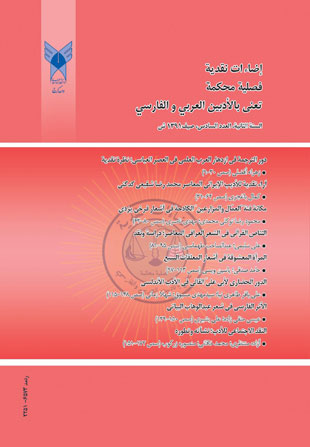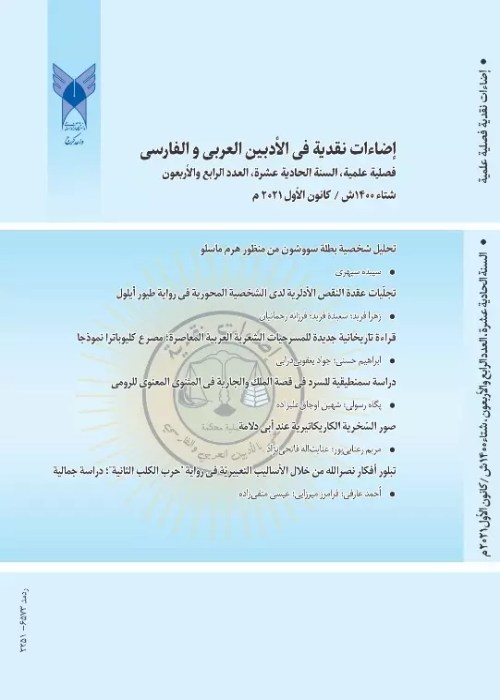فهرست مطالب

فصلنامه إضاءات نقدیه فی الادبین العربی و الفارسی
پیاپی 6 (صیف 2012)
- تاریخ انتشار: 1391/05/25
- تعداد عناوین: 8
-
-
صفحات 97-113
-
صفحات 115-128
-
صفحات 129-150
-
صفحات 151-172
-
Pages 9-30Translation is one of the main mediums of communication among nations of the world. Familiarity with culture and civilization of other nations requires knowledge of their language. Translation conveys concepts, sciences and cultural technology to other cultures and results in their growth and flourishing.Historical investigation shows that translation played a significant role in the transmission of foreign cultures to Arabic culture and helped it grow in Abbasid era. In this era, Arabs made connections with civilized nations such as Iran, India and Greece and translated many of their scientific writings. Translated works attracted translators and scientists attention and they began to study, interpret, criticize, and correct these works. This in turn paved the way for Arabs scientific revolution and soon they began to show initiatives and creativity and made great advances in different fields of science such as medicine, mathematics, astrology, chemistry, physics, philosophy and so on.Keywords: Translation, Scientific revolution, Abbasid era
-
Pages 31-62Shafiee Kadkani the Iranian poet and writer discusses the Persian poetry’s periods in the last century. He divides these periods in to seven sections and begins with the poetry’s perspective before the Mashrooteh (parliamentary) revolution and then after reviewing the 1953 coup, finishes the discussion with the Islamic revolution.In his instructive method he uses a combination of the literary history and criticism along with offering some samples from various epoch's poetry and at the final stage the author provides a chart of the Persian poetry in the recent 100 years.He speaks of the poetry leaders at each era plus the political, economical, social and other relevant backgrounds as well as their impacts on the currents and trends which have affected the present Persian poetry.Keywords: Shafiee Kadkani, Constitution(Mashrooteh), contemporary Iranian poetry
-
Pages 63-80Form a long time ago Iran has been proud of its champions, thinkers and scholars who did their best for the progress and development of their country. In the meantime, devoted poets who defended their country across their life, are very important and respected by people. Mirza Mohammad Farrokhi Yazdi (1887–October 18, 1939) a Persian/Iranian poet and senior politician of Constitutional era, was one of those, who defended his homeland until he was martyered in this way. One of the characteristics of the poems of the Farrokhi was rejecting dictatorship and fighting with dictators. So in this regard he spared no efforts to defend the workers and farmers who had been oppressd by the Phalavi despotic regime along with the British colonialism. This article reviews the position of worker and farmer in Farrokhi’s poem to show the commitment of this poet to his homeland more than before.Keywords: Farrokhi Yazdi, homeland, farmer, worker, injustice, Colonialism
-
Pages 81-95The Arab poetry has adorned different types of intertextuality which include: mythical, historical, and religious ones. Abundant use of this phenomenon, especially what is called koranic intertextuality, led to the review of this phenomenon. For this means one must identify the strengths and weaknesses imposing a framework for it. Considering the interaction of poet with the holy Koran intertextuality is divided in to several types such as: total and partial intertextuality, referential intertextuality and conceptual intertextuality. Some of these give abeautiful forms to the poetry and some are ugly and unacceptable, because they do not preserve dignity of Koran.It should be noted that the overall shape and detailed koranic intertextuality is more susceptible to error, while the conceptual and referential formsare less affected by slips. This research criticizes and studies koranic intertextuality in modern poetry of Iraq.Keywords: ranic intertextuality, intertextuality reviews, contemporary poetry of Iraq, conceptual intertextuality, referential intertextuality
-
Pages 97-113
As far as "Jaheli " poetry is concerned the main theme is woman the evidence for which is found in the scarcity of ode begun with anything except love, sonnet, description of female beauties and the poet to reach her mysteries. A "Jaheli" poet describes woman beauties primarily fascinated by her face, the beauty of her body quite expectedly, but describing her moral spiritual aspects and an image of her affection as well as the love story between and woman just come after the description of women body. Moreover, Jaheli woman is superior to the ordinary people and enters poet's lives inspiring them with simultaneously encouraging them to create artistic works which results in masterpieces in describing woman and innovation in portraying her beauties. The Jaheli poet portrays an statute of Jaheli woman in whose forehead some signs are evident. His poetry starts from hair and comes to the feet. This is a simile suggesting the secret of life full of morals and spiritual attributes which themselves are ones that Jaheli man appreciates as a whole in the woman.
Keywords: Jaheli woman, physical beauty, sonnet -
Pages 115-128The people of Andalusia emphasized Arabic culture and language and have an important role expanding them. Because of this matter literature and language was important, and the vocabulary was based on these efforts. Abu Ali Al-Ghali is one of the greatest scholars who has a great role in Andalusia culture and literature. He tried to collect books transferring Arabic sources and teaching to kholofa's children. He is one of the greatest writers of dictionaries, a linguist and a scholar. He created a big revolution in literature in Andalusia, taught many students and wrote many books that are famous in east and west.Keywords: Abu Ali Al Ghali, Civilization, Andalusia, Literature
-
Pages 129-150Abdolvahab Albayati is one of the well-known poets of Iraq and Arab contemporary poetry. He has been affected by Persian culture and literature in most of his poems. This research intends to assess some aspects of such effects, and to explain them as far as possible. In this assessment, we will find how Bayati has taken advantage of Persian poets such as Khayyam and Molavi and Attar as symbolic characters and also Persian cities including Neyshabour and Shiraz in his artistic presentation.Keywords: Albayati, Khayyam, Neyshabour, Jalaleddin Rumi, Farideddin Attar, Shiraz
-
Pages 151-172Certainly there is a strong relationship between literature and society and this is what the ancient philosophers and scientists have repeatedly referred to in the theories such as Theory of "Mimesis" and theory of "Reflection" and other ideas.The sociology of literature is one of the main ways in literary studies founded by Marxist dialectic.This study is an attempt to explain the social critique of the literature on descriptive analytical methods and to attribute the thoughts and opinions that have been raised in relation to literature and society. After investigating the theory of "Mimesis", Marxist dialectic theory will be discussed and finally, Lukacs and his follower's theory will be studied due to the fact that there is no contradiction between the sociology of literature and personal literary creations since investigating of literal works without concerning its social context is impossible.Keywords: literary criticism, sociology of literature, Mimesis, Marxist dialectic, the evolutional structuralism


